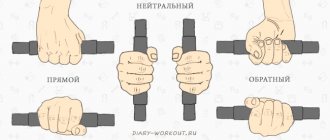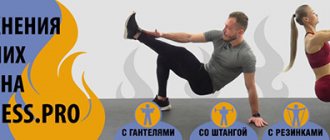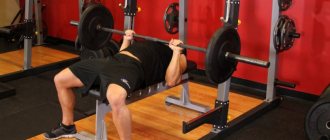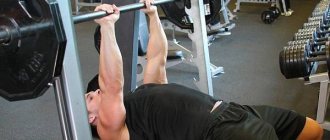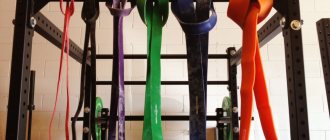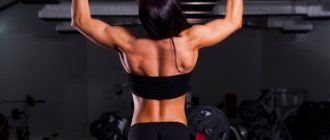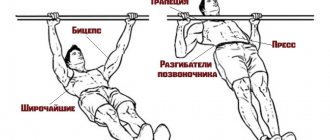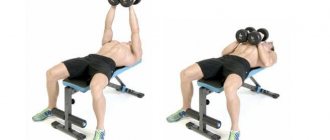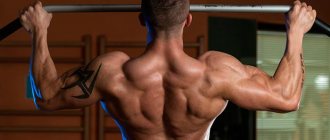Pull-ups are a basic and very effective exercise for developing back muscles. Despite the sparingness of the movement, which is essentially pulling the body by contracting the back muscles upward towards the bar, it is very difficult to perform. And all because initially the athlete lifts quite a lot of weight - his own. However, now you can resort to tricks in the form of elastic bands or a special exercise machine to be able to pull yourself up. This exercise cannot be neglected; it must be included in the training process of any athlete. Why? Let's figure it out now!
Benefits and disadvantages of wide grip pull-ups
- A highly effective exercise for training the back muscles.
- The muscles of the back and, to a lesser extent, the muscles of the arms are maximally involved.
- Strengthen and develop the muscle corset of the upper and middle spine.
- Develop muscle strength, volume and width of the back.
- They make a figure (torso) of the cherished triangular shape for men.
- Improves posture.
- A moderate tensile load is created on the thoracic spine and all the muscles of the core.
- The exercise is not just a posture corrector, but also helps correct diseases such as scoliosis, hyperlordosis, hyperkyphosis and ischemia of the intervertebral discs.
disadvantages . For example, any pull-ups are contraindicated for people with a herniated disc.
What muscles work?
Pull-ups are, in principle, one of the best exercises for working the back muscles. Specifically, pulling up on the horizontal bar with a wide grip is a wonderful load for the upper part of the latissimus muscle, which forms a beautiful wide back.
The main muscles worked during this exercise are the latissimus, rhomboids and teres major. Additional assistant muscles are the shoulder muscles, biceps, and the pectoralis major and minor muscles.
What muscles work when doing pull-ups on the horizontal bar with a wide grip?
When performing wide-grip pull-ups, the rhomboid, latissimus, teres and trapezius muscles are the first to be loaded. Also involved in the work: the posterior bundles of deltoid muscles, biceps, forearms. When performing wide-grip pull-ups, the spinal extensors, serratus anterior muscles, and abdominal muscles act
as stabilizer muscles
How to do pull-ups correctly?
For wide-grip pull-ups to be beneficial for your back, you must perform all movements technically correctly. Before the exercise, you need to stretch your joints and ligaments well. Warm up all muscle groups in the body. Follow the exact movement algorithm:
- Starting position – grab the bar with a wide straight grip. Thus, the necessary load will be received by the muscles of the back, not the arms.
- Straighten your legs completely (you can also bend them at the knee joint). The gaze is directed forward.
- Take a deep breath and then start moving upward. Tighten your latissimus dorsi and exhale at the end of the movement.
- At the top point, you should try to tuck your chin behind the bar. Fix the position of your elbows, do not move them in different directions.
- Smoothly lower yourself to the starting position, straighten your arms.
- Do as many reps as you can.
Many athletes make a number of mistakes while moving. You should not do pull-ups with a reverse grip, as the load will be distributed to the biceps. Work smoothly, without jerking. The main goal is to increase muscle mass and make your back wider. You need to take a short break between approaches.
Wide grip pull-up technique
- The starting position is hanging on the horizontal bar with your arms positioned at the optimal width, which is determined empirically, approximately one and a half shoulder widths.
- The arms in this position are fully straightened at the elbow joints. The lower back is relaxed.
- As you exhale, using the force of the target muscles, we pull the torso towards the bar. Try to touch the bar with your chin. The movement is performed smoothly, without jerking or other auxiliary movements.
- As you inhale, perform the reverse movement. This movement is also performed smoothly.
Technique
Wide grip pull-ups are performed as follows:
- Starting position - hanging on the horizontal bar. Wide grip (about 20 centimeters wider than shoulder width), hands facing away from you. The arms are straight and relaxed, the grip is maintained, only the forearms are tensed. You can catch the right feeling if you imagine that your hands are just fasteners, hooks or ropes on which your body hangs on the horizontal bar. Take a deep breath.
- Feeling the tension in your lats, pull yourself up on the bar to your chest, exhaling. Do not bring your elbows towards your body; try to fix their position.
- At the top, aim for the bar to be level with your upper chest. Simply put, your chin should be higher than the bar. The forearms should be parallel to each other and, accordingly, perpendicular to the floor.
- Lower yourself to the starting position smoothly while inhaling. Strive to lower yourself under control, feeling your lats working, and don’t throw your body weight down suddenly. Move on to the next rep.
Please note that the elbows should not be brought towards the body; their position should be as fixed as possible. Otherwise, you will reduce the amplitude of contraction of the target muscles and reduce the effectiveness of the exercise.
During the exercise, there is a great temptation to help yourself by swinging your body on the horizontal bar. We strongly advise against simplifying your life in this way. Only if you follow the correct technique, pull-ups work at full strength, otherwise you will simply waste your time.
Common mistakes
A common mistake when performing wide-grip pull-ups is using a lot of weight (if performing the exercise with weights), or ignoring the auxiliary equipment discussed (elastic bands or graviton trainer). As a result, the athlete performs a small number of repetitions, and this is not the best way to develop the back. The back muscles love a high number of repetitions, especially if we are talking about pull-ups. Aim for a range of 10 to 15 reps.
Head pull-ups
A very popular variation of wide-grip pull-ups is the overhead pull-up. But at the same time, they are more dangerous and are not recommended for people with problems of the thoracic and cervical spine, as well as shoulder injuries.
The benefits of head pull-ups are that they further target the muscles of the upper back: the lats, trapezius, and teres major. However, even in some healthy people they can cause discomfort in the shoulder girdle, as they require a good stretch.
If you intend to use them, here are a couple of tips on the technique:
- At the top, do not hunch your back. This temptation often arises. A hunched back not only takes pressure off the lats, but can also lead to injury.
- When doing pull-ups, move your whole body forward a little, and move your elbows a little back, squeezing your shoulder blades together. This way you can pull yourself up strictly in a vertical plane and not touch the horizontal bar with the back of your head.
That's all for me, friends. Now you know more about pull-ups! Subscribe to updates and share articles with friends on social networks. Bye!
Implementation recommendations
- Pay attention to your grip width. The wider the grip, the less the arm muscles are used , and the range of movement is reduced.
- In order to reduce the load on the biceps or forearms, you can resort to using wrist straps or hooks.
- Wide-grip pull-ups should be the first exercise to develop your back muscles. The optimal execution scheme would be 3-4 sets of 10-15 repetitions.
- Is it possible to perform several variations of pull-ups at once? I guess, yes. For example, the first option is a wide grip behind the head, and the second is a reverse grip. In this type of training, the number of approaches should be reduced to 2-3.
How to create a training program with pull-ups?
Pull-ups can be performed not only on the back. It is best to combine different types of exercise in one workout. Vary your grip width and intensity of movements.
Athletes who work out in the gym should do pull-ups while pumping their back. It is best to perform this sports element at the beginning of training. Also during the lesson you can do rows of a sports equipment to the belt or rows of a horizontal and vertical block. Warm up well before doing pull-ups. You can wear special gloves on your hands. Perform 10-12 reps for 4 sets.
Determine the main goal of the lesson. To work out the relief, you can do the maximum number of repetitions per approach. To increase muscle mass, exercise with weights. To do this, you can put a briefcase with a load on your shoulders, and also attach a barbell weight to your belt.
If you do not have the opportunity to exercise with heavy sports equipment, try to constantly change the width of your grip. Exercise with a narrow position of the arms will contribute to the development of the biceps. You can also turn your elbows slightly to the side.
Wide-grip pull-ups should be a key part of any back workout. After some time, you will notice serious changes in your figure. Strength indicators in other exercises will increase several times.
A workout program for beginners will help develop strength indicators.
Inclusion in the program
Typically, for those whose priority is bodybuilding, and not improvement in the snatch, clean and jerk, or deadlift, pull-ups on the horizontal bar with or without weight are the first exercise in the training program. Performed in 3 or more working sets of 10-15 repetitions. If the athlete can perform more than 15 repetitions, they need to add weights to the belt, or work in a weighted vest.
Pull-ups are performed in combination with back rows and other exercises that promote muscle development.
Very detailed and useful guide with video.
Still from the film
The horizontal bar in Russia, and not only in it, is the most popular and affordable projectile of all. It is even more popular than weights and parallel bars, and all because it is found in every yard, and for many it is proudly located at home on the wall or in the doorway.
We do pull-ups with both and one arm, do lifts with inversions, just hang, but most importantly, we constantly ask ourselves the question: “When doing pull-ups on the horizontal bar, what muscles are working?” In this article I will give you my detailed and extensive answer to this popular question.
Errors
Technical errors in wide-grip pull-ups are varied. These include “small”, that is, small amplitude, lifting, and too much swinging of the body, and active kicks with the legs. Any swings, inertial movements and attempts to somehow push the body towards the crossbar, rather than rise to it using muscle strength, are considered violations of technique.
It is not recommended to do pull-ups with a relaxed back, performing the main movement only with the strength of your arms - namely, with your biceps. Kipping pull-ups used in gymnastics and crossfit along an elliptical trajectory are considered a technical error in classical bodybuilding.
An open grip, that is, the position of the fingers when the thumb is on top of the bar, is considered a technical error in street lifting and workout, but does not apply to such in the context of regular muscle pumping. Another thing is that this position of the fingers overloads the forearms and forces them to do extra work.
Movements with a small amplitude are not very good for pumping up the back muscles, they only allow you to strengthen the biceps, but the latissimus simply “does not reach the load.” The use of this technique leads to the fact that a person does not train his back muscles, but engages in self-deception.
Two main exercises on the horizontal bar for the power of your back and one big mistake.
What exercises on the bar do: what muscles are involved?
A novice athlete should know which muscles work when doing pull-ups on the horizontal bar. To do this, you need to study the structure of the muscles of the upper torso. This will help him effectively pump up his muscles and, if necessary, work out lagging bundles.
When lifting and lowering, many muscle groups are loaded. This exercise effectively strengthens the entire body. Even the muscles of the buttocks and lower extremities are involved in the work. However, the muscles of the upper body are subject to maximum load.
First of all, the hands and forearms are loaded, as the athlete grabs the bar and hangs. And when raising and lowering the body, the muscles of the back, the belts of the upper extremities, large muscle groups of the arms, and the abs are loaded. The abdominal muscles allow you to fix the body when pulling up.
Important! But in order to effectively pump up your muscles, you need to follow the technique of performing different types of pull-ups. They are performed only by straining the arms and back; swinging the body is prohibited. You need to move smoothly, rising as you exhale, descending as you inhale.
Hands
As mentioned earlier, the forearms are loaded first, which includes the following muscle structures:
- Muscles that flex and extend the wrist.
- The brachioradialis muscle, which is located on the front surface of the forearm. It helps bend the limbs at the elbows.
- The pronator is a biceps muscle that originates from the shoulder, passes through the elbow, and attaches to the radius. Helps turn your palms down.
- The arch support is located on the back of the forearm and allows you to turn your palm up.
These muscles help the athlete grab the base of the horizontal bar.
The biceps (biceps muscle) consists of two bundles that are located on the front surface of the shoulders. With its help, the athlete bends the limb and fixes the elbow at the top. This is an auxiliary muscle group when training on the horizontal bar.
The deltoids are located on the front surface of the shoulders; they form their contour. They help to bend and straighten the shoulder, and move the arm to the side. The deltas consist of an anterior, lateral, and posterior bundle. During the pull-up, they are strengthened (except for the posterior bundle), but are not loaded to the maximum.
Back
The lats are the largest muscle group located in the lower back. They help pull the arm down and back when it is above your head. Thanks to the lats, the athlete can lift the body and move the shoulders back.
When doing pull-ups, the trapezius muscles are maximally loaded. These are large paired muscles that start from the back of the neck and reach the middle part of the back. They allow you to move your shoulder blades and support your upper limbs.
The rhomboid muscle is located under the trapezius. This is a small diamond-shaped muscle group that consists of 2 bundles. It allows you to keep your back straight and stabilizes the shoulder blade at the back.
The teres major muscle has a flat and elongated shape. It is located under the latissimus muscle. It helps to pull the torso towards the elbows and pull the shoulders back.
The pectoralis major and minor muscles play an auxiliary role when pulling up. They help the back stabilize the torso, pull it, raise the arms to the shoulders, rotate the shoulder blades down.
Stomach
When lifting and lowering the body on the horizontal bar, the muscles of the middle part of the body are loaded. This group consists of the rectus, oblique, transverse muscles, as well as the muscle that is responsible for straightening the body.
This is an important area that is involved in performing movements of the whole body, helps to hold it during training, and forms correct posture when the athlete sits or stands. The abdominal muscles are loaded and when the athlete pulls himself up.
Be sure to check out:
Gallery image with caption: Swinging on parallel bars and the horizontal bar: an effective training program Gallery image with caption: Pull-up program on the bar: technical nuances and tips Gallery image with caption: Training on the horizontal bar: exercises and methods Gallery image with caption: Pull-ups on the horizontal bar for health and body beauty
Other types of pull-ups on the horizontal bar
When your muscles are sufficiently strong as a result of training on the horizontal bar, you will be able to perform various techniques on the horizontal bar, such as “lift-over”, “exit on one”, “exit on two” and others. Also, perhaps, after hard training, you will be able to perform pull-ups with clap or other complex elements.
But first, learn how to do a lot of pull-ups using the types of pull-ups we discussed today. Don't rush to invent something. All the same, the muscle groups used in different pull-up methods are the same, and if you can perform standard pull-ups efficiently, you can easily perform any other type of pull-up.
